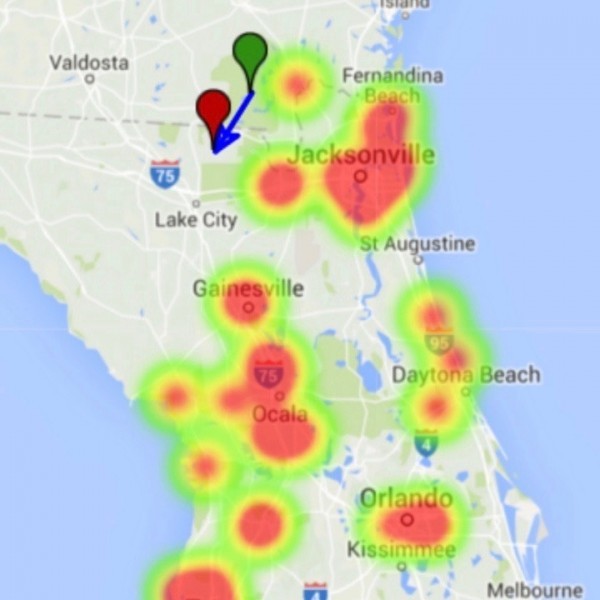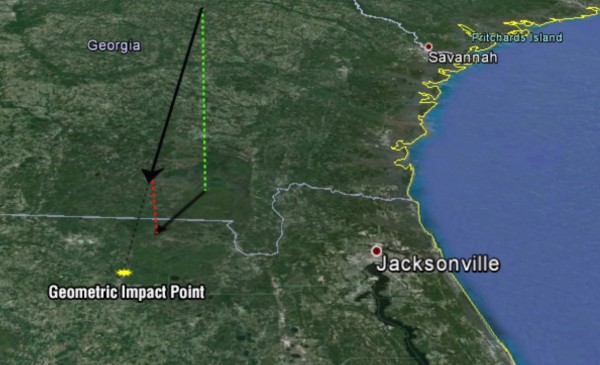.

View larger. | A portion of a ‘heat map’ – showing location of witnesses or observers, and ground trajectory – of January 24, 2016, daylight meteor via the American Meteor Society.
-
The American Meteor Society says there are now over 100 reports of a very bright meteor seen over a large portion of northern Florida, southeast of Georgia and even South Carolina on Sunday, January 24, 2016. The huge meteor was seen in broad daylight near 10:25 a.m. ET. Most observers say the bright meteor showed an orange color.
People in various cities, including Jacksonville and Orlando, Florida, reported the daylight meteor. However, a preliminary trajectory suggests the meteor was moving from southeast Georgia to north Florida, and there is a possibility that fragments of the space rock may have reached the surface a few miles north of Lake City, Florida.
If you are located in Florida or Georgia, try looking for the meteor on recordings from your outdoor security cameras. Without knowing it, you may have collected images of the extremely bright meteor fall that occurred on January 24 near 10:25 a.m. ET. If you find any, please share them with EarthSky!
Some people see what they think is a daylight meteor, but often they just see a slow contrail produced by high flying aircraft. However, the event that occurred this weekend seems to have been a real meteor.
.

3D trajectory estimation of January 24, 2016 daylight meteor via the American Meteor Society.
-
How can you tell if you saw space junk instead of a natural meteor?
There are thousands of objects orbiting Earth that are considered space junk. Most are rocket stages and other related parts, which after circling our planet for some time may re-enter the atmosphere and disintegrate. If this happens, the object usually shows a lot of fragments and looks considerably slower than a natural (space rock) meteor.
Other natural meteors are related to comet debris, but those are relatively small and disintegrate as a result of atmospheric friction.
However, a huge meteor, especially a meteor bright enough to be seen in broad daylight, may be a space rock with a size that ranges between a few inches and a few feet. The reported fast speed of the daylight meteor seen this weekend, which lasted just a few seconds, suggests it is a natural meteor.
Why do some space rocks enter Earth’s atmosphere without being detected?
Smaller asteroids are more difficult to detect. Asteroid detection programs usually can detect rocks with a size at least 1 to 4 meters (3.2 to 13 feet) or bigger. This limitation is of no concern because rocks of this size and smaller usually disintegrate and any surviving fragments should not cause significant damages.
Space rocks may usually be dark and do not emit light; astronomers detect those objects when they dimly reflect sunlight. But as asteroid detection programs becomes more effective, we can see a lot more space rocks that come close to Earth. This means it was, and is happening all the time, but we are beginning to detect space rocks that were passing before undetected.
The 17-meter (55-foot) space rock that penetrated the atmosphere over Chelyabinsk, Russia on February, 2013, was not detected before because it was approaching Earth from the sun’s direction. That meteor – which broke windows in six Russian cities and caused more than 1,500 people to report in with injuries, mostly from flying glass – is a reminder of how important it is to support and improve the asteroid detection programs, such as NASA’s Near-Earth Object program.
On January 2016, two small asteroids came very close to our planet, closer than 0.1 times the Earth-moon distance. Asteroid 2016 AH164 passed on January 12 at just 0.07 times the distance to the moon. That equals to just over 16,000 miles (25,750 km) from Earth’s surface.
For comparison, geostationary satellites like those used for meteorology and satellite TV orbit our planet at some 22,300 miles (36,000 km).
Fortunately, bigger asteroids are a lot easier to detect. But as for the smaller ones, they just may produce an impressive meteor, like the one seen in broad daylight last weekend.
Keep watching the skies!
Bottom line: People in a broad swath across the southeastern U.S. reported a daylight meteor on January 24, 2016, near 10:25 a.m. ET. Fragments of the space rock may have reached the surface a few miles north of Lake City, Florida. Check your outdoor security cameras for images of this event, which you can submit to EarthSky here. If you saw it, report it here to the American Meteor Society.
Quelle: EarthSky
4457 Views
